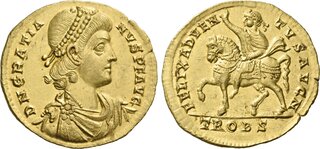| Numismatica Ars Classica > Auction 146 | Auction date: 8 May 2024 |
| Lot number: 2422 Price realized: This lot is for sale in an upcoming auction - Bid on this lot  | Show similar lots on CoinArchives Find similar lots in upcoming auctions on |
| Lot description: Gratian, 367 – 383. Medallion of 1 ½ solidus, Treveri circa 375-378, AV 26 mm, 6.71 g. D N TGRATIA – NVS P F AVG Pearl-diademed, draped and cuirassed bust r. Rev. FELIX ADVEN – TVS AVG N The emperor riding l. on horse and saluting with r. hand, his cloak billowing behind him; in exergue, TROBS. C –. Alföldi –. RIC 33b var. (TROBC). Bastien Donativa p. 97 (TROBC). Depeyrot p. 292 EST(TROBC). An apparently unrecorded variety of a type of the highest rarity and one of very few gold medallions of Gratian known. A portrait of excellent style struck on a very large flan and a fine ly detailed reverse die. Good extremely fine Gratian, the eight-year-old son of Valentinian I, was elevated to the rank of Augustus to rule the Western Roman Empire alongside his father on 24 August 367. When his father died in 375, Gratian assumed sole authority. Six days later he was forced to share the imperial title with Valentinian II, his four-year-old half-brother who had been proclaimed by the army campaigning with their father. Officially, the Western Empire was divided between Gratian in Gaul and Britannia and Valentinian II in Italy, Illyricum, and Africa, but in reality, Gratian was the real power throughout. Four-year-olds are not as difficult to control as is sometimes thought. Thanks to the support of Frankish commanders Gratian inflicted a major defeat on the Germanic Lentienses in 378 and forced them to supply soldiers for his army. This success was quickly followed by disaster when Gratian's uncle Valens, who was also the Eastern Roman Emperor, fell in battle against the Ostrogoths at the Battle of Adrianople. Gratian to quickly marched east to deal with the crisis, but the Gothic assault on the Danubian provinces that followed and rumors of an impending invasion by the Alemanni convinced him to appoint Flavius Theodosius (I), the retired dux Moesia Prima (Duke of Upper Moesia) to rule as a new Augustus in the Eastern Empire. Theodosius I proved to be an excellent colleague and within four years he had brought an end to the immediate threat of the Ostrogoths. At the same time, Gratian was losing his former popularity in the Western Empire. His extreme Nicene Christian orthodoxy lost him support in the still strongly pagan Roman Senate. He famously ordered the removal of the old Altar of Victory from the Senate House in 382. Likewise, in Gaul, where he repressed the popular Christian ascetic movement of Priscilian. Gratian increasingly withdrew from public affairs in order to hunt and surrounded himself with a new bodyguard of Scythian archers. His excessive favoritism towards the Scythians alienated the Roman and Germanic elements of the western army, and in 383 provided the excuse for Magnus Maximus to revolt in Britannia. Maximus soon crossed the English Channel with a large army and immediately gained support in Gaul. Gratian was abandoned by his own troops and fled to Lugdunum (Lyon), but he was captured and killed by Andragathius, Maximus' magister equitum (Master of the Cavalry). This beautiful solidus multiple was struck for distribution as a donative to the army on the occasion of Gratian's arrival at Treviri (Trier). Considering the location of the issuing mint at Treviri, an important city from which Roman campaigns along the Rhine frontier were often launched, it seems very likely that it celebrates the arrival of Gratian to personally defend the frontier against the Lentienses. The presence of the emperor contributed to the Roman victory at the Battle of Argentovaria in May 378, which saw the death of Priarius, the king of the Lentienses, and the last time a Roman emperor would fight beyond the limits of the frontier fortifications. Estimate: 60000 CHF |  |



